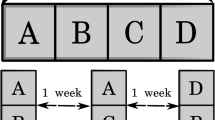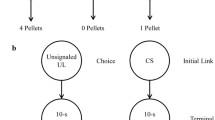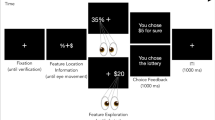Abstract
When humans face probabilistic outcomes, their choices often depend on whether the choice is framed in terms of losses or gains. In the present research, we gave pigeons a choice between risky (variable) outcomes and safe (constant) outcomes that resulted in the same net reward. In Experiment 1, in which the outcomes represented a loss, the pigeons preferred the risky alternative. In Experiment 2, in which the outcomes represented a gain, the pigeons were indifferent between the two alternatives. In Experiment 3, in which the outcomes represented neither a gain nor a loss, the pigeons strongly preferred the risky alternative. The results were interpreted in terms of the relative value of gains and losses given to the alternatives by pigeons in the context of a risky and safe choice. In Experiment 4 we tested that hypothesis by giving pigeons a choice between a risky and safe alternative with the same net outcome, in the context of a gain associated with the safe alternative, but no gain or loss associated with the risky alternative. In support of the interpretation of the first three experiments, with the safe alternative associated with a gain, the pigeons now preferred the safe alternative. These results were discussed in terms of economic and foraging theories and were contrasted with the aversion to uncertainty (risk) more typically shown by humans.






Similar content being viewed by others
References
Becker G (1976) The economic approach to human behavior. University of Chicago Press, Chicago, IL
Chen MK, Lakshminaryanan V, Santos L (2006) How basic are behavioral biases? Evidence from capuchin monkey trading behavior. J Political Econ 114:517–532
Clayton WD, Zentall TR (2021) Pigeons are attracted to a perceived gain without an actual gain. Anim Cog 24:605–611
Gilovich T, Griffin D, Kahneman D (2002) Heuristics and biases: the psychology of intuitive judgment. Cambridge University Press, New York
Gneezy U, List JA, Wo G (2006) The uncertainty effect: When a risky prospect is valued less than its worst outcome. Quart J Econ 121:1283–1309
Kahneman D, Tversky A (1979) Prospect theory: An analysis of decision under risk. Economet 47:263–292
Kahneman D, Slovic P, Tversky A (1982) Judgment under uncertainty: Heuristics and biases. Cambridge University Press, Cambridge, UK
Lakshminarayanan V, Chen MK, Santos LR (2011) The evolution of decision-making under risk: Framing effects in monkey risk preferences. J Exp Soc Psychol 47:689–693
Marsh B, Kacelnik A (2002) Framing effects and risky decisions in starlings. Proc Nat Acad Sci 99:3352–3355
Menger C (2007) Principles of Economics. Alabama: Ludwig von Mises Institute, (Orig. pub. 1871).
Odean T (1998) Are investors reluctant to realize their losses? J Finance 53:1775–1798
Simon HA (1955) A behavioral model of rational choice. Q J Econ 69:99–118
Simonsohn U (2009) Direct risk aversion: Evidence from risky prospects valued below their worst outcome. Psych Sci 20:686–692
Stephens DW, Krebs JR (1986) Foraging theory. Princeton University Press, Princeton, NJ
Sturgill J, Bergeron C, Ransdell T, Colvin T, Joshi G, Zentall TR (2021)“What you see may not be what you get”: Reverse contingency and perceived loss aversion in pigeons. Psychon Bull Rev, 28:1015–1020.
Tversky A, Kahneman D (1981) The framing of decisions and the psychology of choice. Science 211:453–458
Zentall TR, Raley OL (2019) Object permanence in the pigeon: Insertion of a delay prior to choice facilitates visible- and invisible-displacement accuracy. J Comp Psych 133:132–139
Author information
Authors and Affiliations
Corresponding author
Ethics declarations
Conflict of interest
The authors declare that they have no conflicts of interest.
Ethical approval
All animals were treated in accordance with the Institutional Animal Care and Use Committee at the University of Kentucky. The experimental procedures were according to Protocol # 2020–3675.
Additional information
Publisher's Note
Springer Nature remains neutral with regard to jurisdictional claims in published maps and institutional affiliations.
Rights and permissions
About this article
Cite this article
Clayton, W.D., Brantley, S.M. & Zentall, T.R. Decision making under risk: framing effects in pigeon risk preferences. Anim Cogn 25, 1281–1288 (2022). https://doi.org/10.1007/s10071-022-01610-y
Received:
Revised:
Accepted:
Published:
Issue Date:
DOI: https://doi.org/10.1007/s10071-022-01610-y




